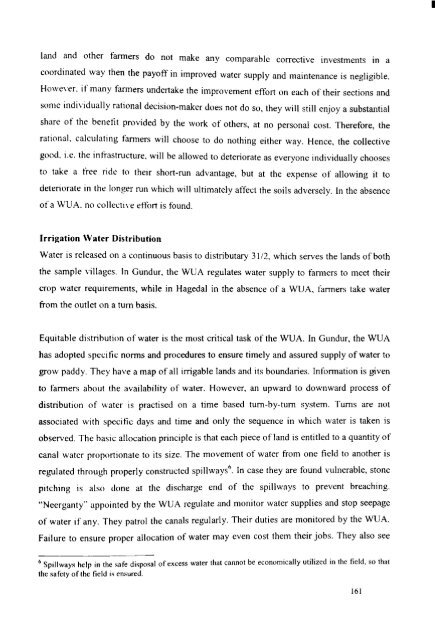Water Users Association and Irrigation Management - Institute for ...
Water Users Association and Irrigation Management - Institute for ...
Water Users Association and Irrigation Management - Institute for ...
Create successful ePaper yourself
Turn your PDF publications into a flip-book with our unique Google optimized e-Paper software.
I<br />
l<strong>and</strong> <strong>and</strong> other farmers do not make any comparable corrective investments in a<br />
coordinated way then the payoff in improved water supply <strong>and</strong> maintenance is negligible.<br />
Howeycr. if many farmers undertake the improvement ef<strong>for</strong>t on each of their sections <strong>and</strong><br />
some individually rational decision-maker does not do so, they will still enjoy a substantial<br />
share of the benelit provided by the work of others, at no personal cost. There<strong>for</strong>e, the<br />
rational. calculating farmers will choose to do nothing either way. Hence, the collective<br />
good. i.e. the infrastructure. will be allowed to deteriorate as everyone individually chooses<br />
to take a free ride to their short-run advantage, but at the expense of allowing it to<br />
deteriorate in the longer run which will ultimately atlect the soils adversely. In the absence<br />
of a WUA. no collectiyc el<strong>for</strong>t is found.<br />
<strong>Irrigation</strong> <strong>Water</strong> Distribution<br />
<strong>Water</strong> is released on a continuous basis to distributary 3112, which serves the l<strong>and</strong>s of both<br />
the sample villages. In Gundur. the WUA regulates water supply to farmers to meet their<br />
crop water requirements. while in Hagedal in the absence of a WUA. farmers take water<br />
from the outlet on a tum basis.<br />
Equitable distrihution of water is the most critical task of the WUA. In Gundur, the WUA<br />
has adopted specitic norms <strong>and</strong> procedures to ensure timely <strong>and</strong> assured supply of water to<br />
grow paddy. They have a map of all inigable l<strong>and</strong>s <strong>and</strong> its houndaries. In<strong>for</strong>mation is given<br />
to farmers about the availability of water. However, an upward to downward process of<br />
distribution of water is practised on a time based turn-by-turn system. Turns are not<br />
associated with specitic days <strong>and</strong> time <strong>and</strong> only the sequence in which water is taken is<br />
observed. The hasic allocation principle is that each piece of l<strong>and</strong> is entitled to a quantity of<br />
canal water proportionate to its size. The movement of water from one field to another is<br />
regulated through properly constructed spillways6. In case they are found vulnerable, stone<br />
pitching is also done at the discharge end of the spillways to prevent breaching.<br />
"Neerganty" appointed by the WUA regulate <strong>and</strong> monitor water supplies <strong>and</strong> stop seepage<br />
of water if any. They patrol the canals regularly. Their duties are monitored by the WUA.<br />
Failure to ensure proper allocation of water may even cost them their jobs. They also see<br />
6 Spillways help in the safe disposal of excess water that cannot be economically utilized in the field. so that<br />
the sa fety of the field is ensured.<br />
161
















